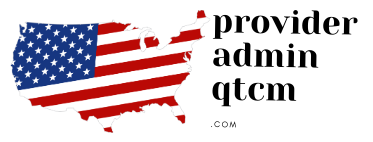
Provider Admin QTC is a revolutionary approach in healthcare management, focusing on quality tracking to enhance patient outcomes and drive organizational efficiency. In the landscape of value-based care, integrating QTC allows healthcare providers to monitor their performance against stringent quality metrics, which is vital for ensuring regulatory compliance and improving patient care. As healthcare organizations strive to provide the highest standard of care, the significance of Provider Admin QTC becomes increasingly pronounced. By leveraging this framework, facilities can systematically identify areas for improvement, thereby transforming the quality of their services. In a world where patient satisfaction and health results are paramount, embracing Provider Admin QTC is not just beneficial—it’s essential.
Provider Admin QTC, often referred to in some circles as Quality Tracking Compliance or Healthcare Quality Management, plays a critical role in enhancing the overall standards of care in healthcare environments. This system emphasizes the collection and analysis of quality metrics that inform healthcare providers on their performance, fostering an environment of continual improvement. Alternatives such as performance oversight frameworks and regulatory compliance systems serve similar purposes, aiming to uplift patient care while ensuring organizations adhere to governmental standards. With a strong focus on value-oriented healthcare delivery, these metrics delineate the path towards greater efficiency and effectiveness in treatment outcomes. Ultimately, these integrated quality management systems are indispensable for modern healthcare practices striving to align with best practices in patient safety and satisfaction.
The Role of Provider Admin QTC in Enhancing Healthcare Quality
Provider Admin QTC is pivotal in measuring and enhancing healthcare quality. By systematically collecting and analyzing quality metrics, it becomes possible to assess how well healthcare providers are performing against nationally recognized standards. This ongoing evaluation is not just beneficial but essential, as it allows organizations to identify any gaps in care. By flagging issues such as low patient satisfaction or inconsistent application of clinical guidelines, Provider Admin QTC fuels a proactive approach to quality improvement, ensuring that patients receive the best possible care.
Moreover, the integration of insights gained from QTC into the day-to-day operations of healthcare facilities contributes significantly to overall service delivery. When teams can see where improvements can be made, they can take targeted actions, such as additional training for staff or revising care protocols. This adaptability is increasingly relevant in an era where patient expectations are rising. Ultimately, the focus on continuous quality improvement through QTC supports the delivery of superior healthcare that aligns with patient needs and outcomes.
Improving Patient Outcomes through Quality Tracking Systems
Effective implementation of Provider Admin QTC leads directly to improved patient outcomes. As healthcare organizations employ quality tracking systems, they gain deeper insights into treatment efficacies and patient feedback. For instance, adjusting protocols based on real-time patient data can directly influence recovery rates, especially among chronic disease patients. Evidence shows that facilities utilizing such QTC frameworks have experienced reduced hospital readmission rates, demonstrating a clear link between monitoring quality and enhancing patient outcomes.
Furthermore, these QTC systems enable healthcare providers to adapt their services to meet the specific needs of their patient populations. Tailoring care plans based on empirical data and patient input not only fosters better health results but also enhances patient satisfaction. Patients who feel that their treatment has been customized to their unique health challenges are more likely to be engaged in their care, leading to improved adherence to treatment regimens and overall health outcomes.
As illustrated in recent studies, when organizations utilize QTC data effectively, they can foster a culture that prioritizes quality performance, resulting in not just better clinical outcomes but also heightened patient trust in their healthcare providers.
The Importance of Regulatory Compliance in Quality Tracking
In the realm of healthcare, regulatory compliance stands as a non-negotiable requirement, and Provider Admin QTC plays a crucial role in ensuring that organizations meet these standards. By employing QTC methodologies, healthcare providers can systematically monitor compliance with regulations set forth by bodies such as the Centers for Medicare & Medicaid Services (CMS). Organizations that leverage QTC tools to track compliance metrics are better positioned to adapt to ever-changing regulations, safeguarding their operational integrity and eligibility for pivotal funding.
The financial stakes tied to regulatory compliance cannot be overstated; failure to comply can lead to penalties or loss of accreditation. By integrating robust quality tracking systems, healthcare providers minimize these risks and enhance overall operational security. Moreover, consistency in compliance monitoring through QTC creates a culture of accountability, where teams understand the importance of meeting standards not just as an obligation, but as a pathway to delivering high-quality patient care.
Operational Efficiency Through Quality Improvement Processes
Provider Admin QTC not only elevates the quality of care but also streamlines operational efficiency within healthcare facilities. By aligning provider activities with both internal goals and external regulatory standards, quality tracking systems can identify redundancies and optimize workflows. In doing so, healthcare organizations reduce administrative burdens and focus more on direct patient care activities, enhancing both employee satisfaction and patient experiences.
Moreover, as QTC fosters greater operational efficiency, it simultaneously drives cost-effectiveness. Resources that were previously misallocated can be redirected towards areas that directly impact patient care. Organizations that adopt QTC frameworks often report improvement in staff morale, as less time spent on compliance issues translates to more time spent on patient interaction, a crucial element in the healthcare environment that leads to better patient outcomes.
Support for Value-Based Care Models
In an evolving healthcare landscape increasingly focused on value-based care, the importance of Provider Admin QTC cannot be overstated. Value-based care emphasizes the quality of services over quantity; therefore, tracking quality metrics becomes essential for healthcare providers to succeed within this framework. QTC equips healthcare organizations with the necessary tools to assess their value propositions accurately, enabling them to qualify for incentive programs that reward high-quality care.
As organizations utilize QTC to demonstrate their commitment to improving patient outcomes while managing costs, they can secure funding that supports continued enhancement of care delivery. This alignment of incentives with quality tracking not only benefits providers financially but also fosters a culture of continuous improvement within organizations. In a value-based care environment, the integration of QTC becomes a strategic asset, driving both clinical efficiency and heightened patient satisfaction.
Harnessing Technology in Quality Tracking Systems
The integration of advanced technologies into Provider Admin QTC frameworks represents a revolutionary advancement in healthcare management. With tools like Electronic Health Records (EHR) and Artificial Intelligence (AI), organizations can gain real-time insights into patient care and operational processes. Such technological enhancements streamline the quality tracking process, making it easier to collect, analyze, and act upon critical data that can lead to better patient outcomes and operational efficiency.
For instance, AI algorithms can analyze patterns in patient data, identifying potential health risks before they escalate, thereby allowing for proactive interventions. This application of technology not only supports better clinical decisions but also reinforces the essential role of QTC in contemporary healthcare delivery. As facilities become more adept at leveraging technology, they pave the way for innovative practices, ensuring that both quality tracking and patient care evolve in tandem with emerging advancements.
Frequently Asked Questions
What role does Provider Admin QTC play in enhancing patient outcomes?
Provider Admin QTC is instrumental in enhancing patient outcomes by employing quality tracking metrics that inform healthcare providers on treatment effectiveness and patient feedback. By analyzing this data, organizations can fine-tune care plans, reduce hospital readmissions, and ultimately improve the overall health of patients.
How does Provider Admin QTC ensure regulatory compliance in healthcare settings?
Provider Admin QTC helps ensure regulatory compliance by monitoring adherence to standards set by organizations like the Centers for Medicare & Medicaid Services (CMS). With effective quality tracking systems, healthcare organizations can adapt to regulatory changes promptly, thereby avoiding penalties and ensuring eligibility for funding programs.
In what ways can Provider Admin QTC improve operational efficiency?
Provider Admin QTC enhances operational efficiency by aligning provider activities with organizational goals, reducing redundancies, and optimizing workflow. This improves resource management and lowers administrative burdens, allowing healthcare staff to focus more on patient care rather than compliance tasks.
What are the benefits of implementing a Provider Admin QTC system for value-based care?
Implementing Provider Admin QTC systems is crucial for value-based care as they track critical quality measures that can enhance patient outcomes and efficiency. This tracking enables providers to qualify for incentive programs, thereby aligning financial rewards with improved patient care experiences.
How can advanced technology improve the effectiveness of Provider Admin QTC?
Advanced technologies such as Electronic Health Records (EHR) and Artificial Intelligence (AI) significantly improve Provider Admin QTC by enabling real-time data analysis and automated reporting. This technological integration allows healthcare organizations to efficiently identify trends and make data-driven decisions that enhance patient care.
What are the key quality metrics used in Provider Admin QTC?
Key quality metrics in Provider Admin QTC include patient satisfaction scores, adherence to clinical guidelines, and outcomes related to chronic disease management. These metrics help healthcare organizations benchmark provider performance and identify areas for improvement.
How does Provider Admin QTC foster a continuous improvement culture in healthcare organizations?
Provider Admin QTC fosters a culture of continuous improvement by regularly collecting and analyzing quality data, thus encouraging healthcare providers to adjust practices based on performance insights. This ongoing feedback loop promotes transparency and accountability, leading to enhanced care quality.
| Aspect | Impact |
|---|---|
| Provider Admin QTC | Improves patient outcomes through monitoring care quality and efficiency. |
| Quality of Care | Enhances care quality via systematic monitoring and feedback. |
| Patient Outcomes | Leads to tailored care plans and reduced hospital readmissions. |
| Operational Efficiency | Streamlines processes and reduces administrative burdens. |
| Regulatory Compliance | Ensures adherence to healthcare standards, avoiding penalties. |
| Support for Value-Based Care | Facilitates tracking of quality measures for incentives. |
| Technology Integration | Utilizes advanced technologies for real-time data analysis. |
Summary
Provider Admin QTC is essential in enhancing healthcare management by systematically improving quality and efficiency. As evidenced, the continuous monitoring and assessment facilitated by QTC not only uplift patient outcomes but also align healthcare practices with regulatory standards, fostering a culture of excellence. For any healthcare organization aiming to thrive within today’s challenging environment, the adoption of Provider Admin QTC is not merely beneficial; it is imperative. Embracing this framework ensures not just compliance but a transformative approach that prioritizes patient satisfaction and operational efficacy.

Leave a Reply